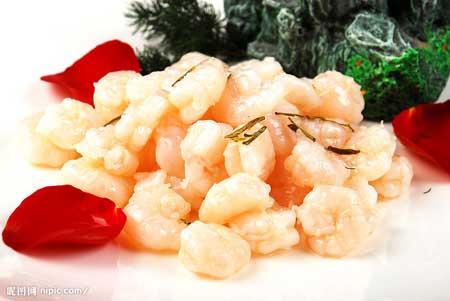 |
| Longjing prawn (Photo: Global Times) |
BEIJING, May 22 -- Rather than swallowing tasteless pills to ward off illness, why not find a prescription that also satisfies the appetite? Sipping antioxidant-rich spring teas is a nice alternative, but comes with the con of frequent visits to the restroom.
That's where cooking with tea comes into play - one still reaps the healthy benefits of the brew, but in a way that's flavorful and filling. Lifestyle presents guidance for how to best eat what's better known as a traditional drink.
Tea for health
Tea is chock-a-block with nutrition; for instance, green tea contains vitamin C. Oolong, as a half-fermented tea, is good for digestion, and its huge dose of theanine, compared to many other teas, helps it to break down the fats in your body. Green tea is said to increase longevity, ward off cancer and reduce inflammation; dishes using it include green tea and tomato soup, a nice food therapy for reducing internal heat on hot days.
"Normally tea is for drinking, while its merits for use as an ingredient are countable," said tea master Xie Siwen. Tea in cooking functions to season food and to reduce greasy flavors, he explained, and "different teas have different flavors as well as medical-like roles." For instance, green tea should be avoided when one has a stomach illness, but red tea can be good for soothing that very problem.
How to incorporate tea in food, then? Little dumplings (xiaolongbao), for example, are filled with chrysanthemum tea to reduce body heat. Note there's a time and place for cooking with tea leaves, and it's never with meat. "Tea is not suitable to eat with meat of any kind," Xie said, "otherwise it might cause constipation." However, using lightly brewed tea water skirts this problem, so some meat dishes that include tea are made using the water alone.
Longjing tea functions as a diuretic and similarly to antibiotics; its theanine content purportedly makes it a good prescription for alleviating symptoms of hepatitis. A popular dish including this tea is longjing prawns. Like longjing, tieguanyin tea also helps eliminate greasy tastes in food, as well as aiding food digestion and purging toxins from the body. A typical Beijing cuisine, tieguanyin short ribs in chestnut soup, is a classic.
Chrysanthemum tea also gets a fair shake in cooking, especially in soups like red jujube. Like the tea itself, this dish may help reduce heat in the body.
There is one side effect of tea (when drinking or eating) not to be overlooked: insomnia. Yes, tea can be used to treat many conditions, but sleeplessness is not one of them.
This is a typical river shrimp dish stewed with longjing tea leaves. Timing is essential: after stirring the prawns for 15 seconds in a wok, remove the oil entirely before adding steeped longjing tea leaves. To preserve freshness, the whole process should take no more than 10 minutes. A famous dish in Hangzhou, these prawns come with their own origin myth: emperor Qian Long traveled to the southern part of China in spring, where a local tea planter presented him with longjing tea.
He brought it back to the palace, where the royal cook experimented with it in cooking until he eventually created this dish.
Related News
Photos
More>>trade
market
- Vice Minister Niu Dun Meets with Irish Assistant Secretary of Agriculture,
- Chinese Premier urges efforts for quick summer grain harvest
- Symposium on Agricultural Cooperation Between China and Baltic States Held in
- Vice Minister Niu Dun Meets with Chairman and CEO of Kverneland Group
- China's May exports up 48.5%
finance
- Vice Minister Niu Dun Meets with Brazilian Minister of Fisheries and Aquaculture
- Chinese cherry hits the market
- Vice Minister Niu Dun Meets with Ukrainian Ambassador to China
- 2010 Forum of Chinese Fishery Economists Held in Beijing
- International Conference on Chinese Caterpillar Fungus Held in Qinghai





